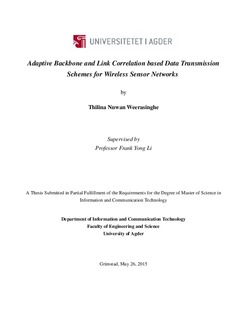| dc.contributor.author | Weerasinghe, Thilina Nuwan | |
| dc.date.accessioned | 2015-09-11T08:09:08Z | |
| dc.date.available | 2015-09-11T08:09:08Z | |
| dc.date.issued | 2015 | |
| dc.identifier.uri | http://hdl.handle.net/11250/299482 | |
| dc.description | Masteroppgave informasjons- og kommunikasjonsteknologi - Universitetet i Agder, 2015 | nb_NO |
| dc.description.abstract | One of the main challenges faced by modern wireless sensor networks (WSN) is rapid energy depletion
of individual sensor nodes. In many applications, sensor nodes are deployed in outdoor environments
and it is difficult to replace or recharge node batteries. Depending on network topology and the transmission
schemes implemented, certain nodes could have higher energy consumption compared with
other nodes. In highly unbalanced load distributions this could lead to early total energy depletion of a
critical node in the topology resulting in what is known as an energy hole in the network. Considering
these factors it is vital that the transmission schemes employed in WSNs are designed to address these
energy constraints. At the same time transmission schemes should be able to achieve the expected
levels of reliability and latency requirements of the applications.
This thesis proposes one basic scheme (BS) and an advanced scheme (AS) considering aforementioned
requirements for efficient and reliable data transmissions. AS scheme would be employed if
100% reliability is required in the network while BS could be employed otherwise. The proposed
schemes utilize the concept of wireless link correlation to minimize the number of transmissions and
hence to reduce the energy consumption. The BS proposes 3 main components, backbone selection criteria,
hop count based back-off algorithm and the selective re-transmission (SR) phase . The backbone
selection method extends the ideas from connected dominating set (CDS) to achieve more balanced
load distribution and the hop count based back-off algorithm aims to reduce the number of intermediate
re-transmissions. In addition,the selective re-transmission (SR) helps to improve the reliability of BS.
The proposed schemes are implemented along with two other transmission schemes in MATLAB
based environment and extensive simulations are carried out for performance evaluation and comparison.
The results show that BS and AS are capable of achieving higher level of reliability with comparatively
low levels of energy consumption and number of transmissions. Furthermore, BS and AS have
better performance in weak correlations than their counter parts like Collective Flooding (CF). The AS
is capable of reaching 100 % reliability in all scenarios for a slightly higher energy consumption compared
with BS. The results reveal also the trade off between energy consumption and reliability in a
WSN. Overall, the proposed schemes could contribute towards the energy conservation of the network
while providing a higher reliability when required. | nb_NO |
| dc.language.iso | eng | nb_NO |
| dc.publisher | Universitetet i Agder ; University of Agder | nb_NO |
| dc.subject.classification | IKT 590 | |
| dc.title | Adaptive Backbone and Link Correlation based Data Transmission Schemes for Wireless Sensor Networks | nb_NO |
| dc.type | Master thesis | nb_NO |
| dc.subject.nsi | VDP::Technology: 500::Information and communication technology: 550 | nb_NO |
| dc.source.pagenumber | 131 s. | nb_NO |
